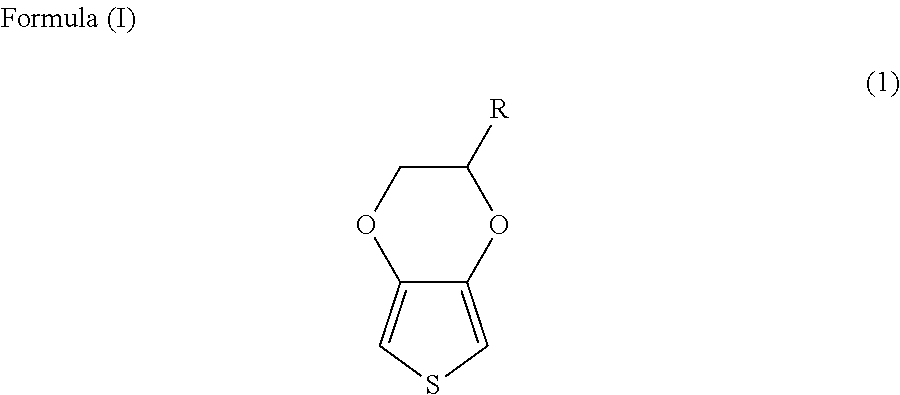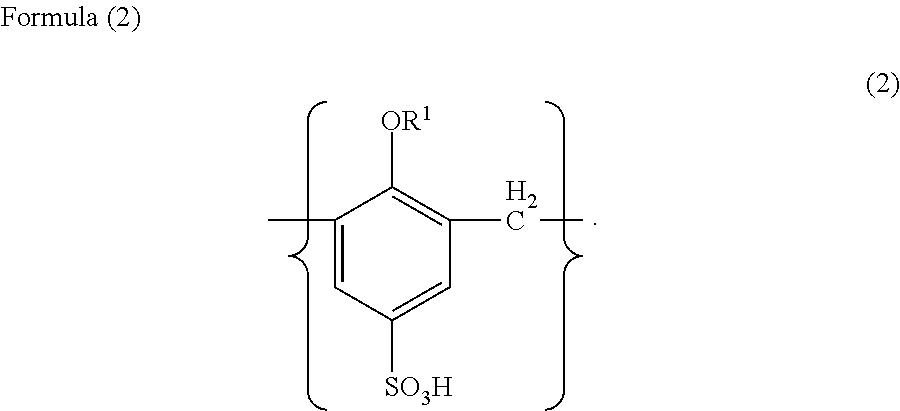Solid electrolyte capacitor and a method for manufacturing the same
a solid electrolyte capacitor and capacitor technology, applied in the manufacture of electrolytic capacitors, capacitor electrodes, electrolytic capacitors, etc., can solve the problems that the electrolyte capacitor only using the conductive polymer above cannot fully satisfy those requests, and still cannot achieve the electrolyte capacitor with a high performance as desired, etc., to achieve superior heat resistance, low conductivity, and high conductivity
- Summary
- Abstract
- Description
- Claims
- Application Information
AI Technical Summary
Benefits of technology
Problems solved by technology
Method used
Image
Examples
preparation example 1
[0097]Into 500 g of γ-butyrolactone put in an 1 L beaker with a stirrer, 50 g of hydroxybenzene carboxylic acid, 5 g of nitrophenol and 1 g of 3-glycidoxypropyltrimethoxysilane were added. By stirring them for 24 hours, a conductive auxiliary liquid was prepared.
[0098]The conductivity of this conductive auxiliary liquid was measured under a condition of 25° C. by using a conductivity measurement instrument (F-55) manufactured by Horiba, Ltd. The conductivity of this conductive auxiliary liquid was 16 μS / cm.
[0099]Here, γ-butyrolactone has a boiling point of 203° C., corresponding to the high boiling point organic solvent with a boiling point of 150° C. or more. Hydroxybenzene carboxylic acid and nitrophenol correspond to the aromatic compound having at least one hydroxyl group. The concentration of the aromatic compound having at least one hydroxyl group in the conductive auxiliary liquid was approximately 9.9%. The ratio of hydroxybenzene carboxylic acid to nitrophenol was 10:1 by m...
preparation example 2
[0100]Into 500 g of γ-butyrolactone put in an 1 L beaker with a stirrer, 50 g of hydroxybenzene carboxylic acid, 10 g of nitrophenol and 5 g of 3-glycidoxypropyltrimethoxysilane were added. By stirring them for 24 hours, a conductive auxiliary liquid was prepared.
[0101]The conductivity of this conductive auxiliary liquid was measured under a condition of 25° C. by using a conductivity measurement instrument (F-55) manufactured by Horiba, Ltd. The conductivity of this conductive auxiliary liquid was 16 μS / cm.
[0102]Here, γ-butyrolactone has a boiling point of 203° C., corresponding to the high boiling point organic solvent with a boiling point of 150° C. or more. Hydroxybenzene carboxylic acid and nitrophenol correspond to the aromatic compound having at least one hydroxyl group. The concentration of the aromatic compound having at least one hydroxyl group in the conductive auxiliary liquid was approximately 10.6%. The ratio of hydroxybenzene carboxylic acid to nitrophenol was 5:1 by ...
preparation example 3
[0103]Into 500 g of ethylene glycol put in an 1 L beaker with a stirrer, 50 g of hydroxybenzene carboxylic acid, 10 g of nitrophenol and 5 g of 3-glycidoxypropyltrimethoxysilane were added. By stirring them for 24 hours, a conductive auxiliary liquid was prepared.
[0104]The conductivity of this conductive auxiliary liquid was measured under a condition of 25° C. by using a conductivity measurement instrument (F-55) manufactured by Horiba, Ltd. The conductivity of this conductive auxiliary liquid was 8 μS / cm.
[0105]Here, ethylene glycol has a boiling point of 198° C., corresponding to the high boiling point organic solvent with a boiling point of 150° C. or more. Hydroxybenzene carboxylic acid and nitrophenol correspond to the aromatic compound having at least one hydroxyl group. The concentration of the aromatic compound having at least one hydroxyl group in the conductive auxiliary liquid was approximately 10.6%. The ratio of hydroxybenzene carboxylic acid to nitrophenol was 5:1 by m...
PUM
| Property | Measurement | Unit |
|---|---|---|
| boiling point | aaaaa | aaaaa |
| conductivity | aaaaa | aaaaa |
| mass % | aaaaa | aaaaa |
Abstract
Description
Claims
Application Information
 Login to View More
Login to View More - R&D
- Intellectual Property
- Life Sciences
- Materials
- Tech Scout
- Unparalleled Data Quality
- Higher Quality Content
- 60% Fewer Hallucinations
Browse by: Latest US Patents, China's latest patents, Technical Efficacy Thesaurus, Application Domain, Technology Topic, Popular Technical Reports.
© 2025 PatSnap. All rights reserved.Legal|Privacy policy|Modern Slavery Act Transparency Statement|Sitemap|About US| Contact US: help@patsnap.com


